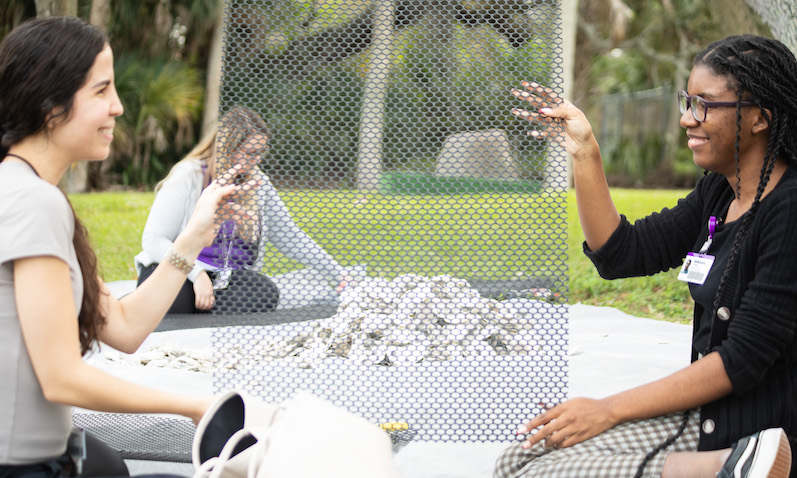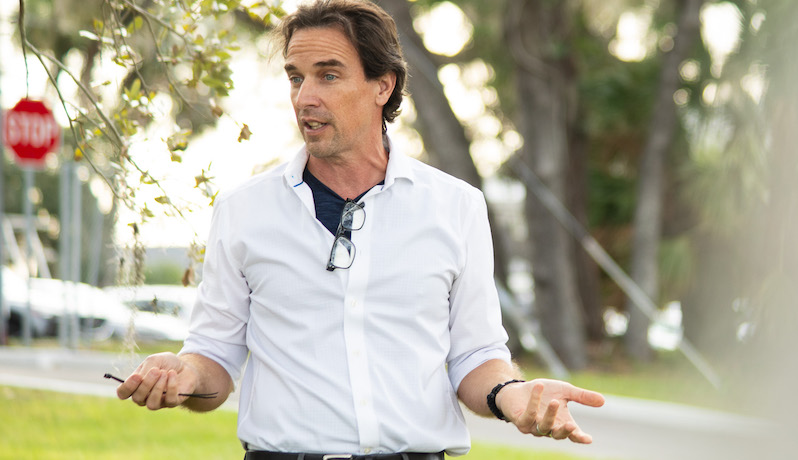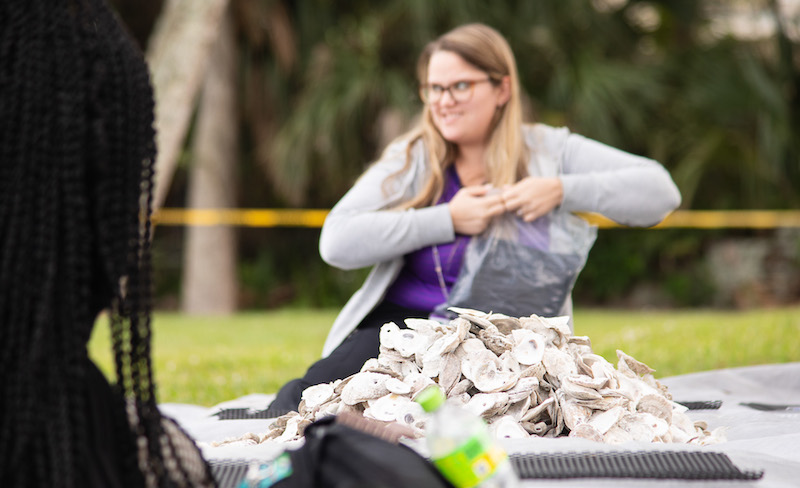Healthy adult oysters serve as an invaluable natural filtration system

Now in its 10th year, Florida Tech’s Living Docs Program Teaches Health First Associates Important Lessons in Teamwork
BREVARD COUNTY, FLORIDA – Quick question: What do oysters and a positive and cohesive work culture have in common?
More than two dozen Health First associate “Culture Champions” found out this week during a collaborative event with Florida Institute of Technology, as they constructed “oyster mats” to help clean and detoxify Brevard’s precious natural resources – particularly the Indian River lagoon – as part of the Living Docks Initiative, led by Robert Weaver, Ph.D., Director of the Indian River Lagoon Research Institute and Associate Professor of Ocean Engineering in Florida Tech’s Department of Ocean Engineering & Marine Sciences.
The program enables non-scientists and community members to create inexpensive but effective habitats that encourage oysters and other organisms such as sponges, sea squirts, and barnacles to collect near man-made structures.
Healthy adult oysters serve as an invaluable natural filtration system, cleaning up to 50 gallons of water per day. In fact, one dock with 37 pilings with an average of 32 oysters per piling can potentially filter up to 21 million gallons of water per year – or the equivalent to over 420,000 bathtubs.

According to Kate Sims, Vice President of Experience and Culture at Health First, the idea to involve employees in a Living Docks opportunity was formulated a few years ago,
“I happened to be at an event where our group was actually participating in a Living Docks opportunity, and I thought about how just a single oyster can make such an incredible impact in the health of the lagoon. They are removing toxins from the water, preventing erosion to the shoreline, creating new habitats for all sorts of life. And I thought, well, man, that sounds a lot like what we do in the workplace, including here at Health First – helping to create a great place for lots
“This is a wonderful opportunity for our Culture Champions, who are already part of a community-based mission at Health First, to come together in a completely different environment to celebrate and recognize the impact they have every day, but also to learn about how their passions, efforts, teamwork and collaboration can affect an entirely different ‘ecosystem’ other than their day to day workplace – in this case, our own natural resources that we as Brevardians have a duty to preserve and protect.”

According to Dr. Weaver, the Indian River Lagoon teemed decades ago with oysters. But over time as the population has grown – and with it, overfishing, pollution and coastal construction such as bridges and seawalls – the oyster population has greatly diminished.
“Besides filtering impurities from our waters, marine species depend on oysters for food and habitat, and large groupings of oysters actually help to create natural reefs- which, in turn, help to prevent shoreline erosion. One solution – oyster mats – are now being constructed and deployed in the Indian River Lagoon as part of our Living Docks program which, I’m proud to say is now in its 10th year, to promote the growth of filter- feeding organisms such as oysters, sponges, barnacles and tunicates along boat docks and sea walls. These oyster mats, essentially large mesh constructions with oyster shells interwoven into the fabric, have the potential to significantly improve local water quality, as well as provide habitat for crabs and fish,” explained Weaver.
Carita Lyn is a remote-based revenue cycle lead with Health First and a member of the Culture Champion group. Being outdoors on a cool, beautiful fall day with her colleagues had many special meanings for Lyn, as she prepared to clear a space for her oyster mat project.
“It’s really special to be outside today with some of my coworkers, not only learning about ways to improve our environment, but also having a chance to do something about it,” said Lyn.
“Health First really makes ongoing earning and community service an important priority, and I’ve already learned a lot about just how important one little clam is for the health of our waters. But it’s nice to also take these lessons about how the clams and other life forms work together to create a healthier environment. That’s similar to our jobs – we all work together, maybe in different locations or doing different things, but it all comes together for a better organization.”

According to Sims, Health First’s Culture Champions movement is shaped by 100+ front-line associates who, like Lyn, are committed to continuously improving the culture of Health First by personifying five core commitments: engage with people; embody the vision; provide input and insight; bring energy; and harvest stories to amplify and celebrate community successes.
“Associate culture champions are part of an organic movement designed to showcase the way associates and leaders partner together to nurture culture locally,” said Sims.
“As we evolve as an organization, so do the champions. Their purpose is fluid and when our leaders pour into the gifts and talents of the champions, they can then “activate” them to influence others.”

Sims says that by participating in the Living Docks opportunity, culture champions will gain a different insight into the concept of removing toxins from the work environment and how each associate contributes to the growth and improvement of that workplace ecosystem.
Florida Tech’s Dr. Weaver agrees, and said he hopes that the takeaway message of how every living part of the community impacts each component will resonate with the Health First participants.
“I was really kind of struck by the community message that Kate tied in with this particular event for her culture champions. You know, I’ve always talked about how it’s not just the oyster … it’s the oyster and ALL the other organisms that come together and settle, and it takes all of those parts together to create that ecosystem to make it healthy. And I didn’t even really think about how that might translate over to a large company,” said Weaver.

The post Health First ‘Culture Champions’ Assist Florida Tech’s Living Docks Oyster Mat Project to Benefit the Indian River Lagoon appeared first on Space Coast Daily.